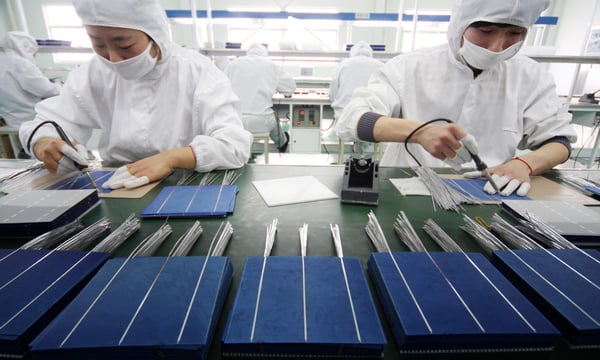Today, China has built vast production and export capacity in clean energy and the upstream materials that support it, supplying over 80 percent of global solar panels and 70 percent of batteries and EVs. This dominance has sparked a growing number of headlines in major media outlets recently warning about a looming “clean energy race” or “battle” with China. These concerns have also filtered into policy across Western capitals: the U.S. Inflation Reduction Act, the EU’s de-risking strategy, and other national industrial policies all reflect deep anxiety about China’s dominance.
At the heart of this anxiety lies a core assumption: that China might leverage its clean energy advantage to advance diplomatic and geostrategic interests – even to coerce.
To some extent, this concern is understandable. China has actively promoted its clean energy leadership as a form of soft power, funding green projects abroad and championing decarbonization through platforms like the Belt and Road Initiative. But whether China would – or even could – turn its clean energy dominance into a coercive tool of statecraft remains an open and far more complex question.
Most current debates reflect Western threat perceptions, emphasizing the geopolitical risks of China’s dominance and the challenges of decoupling. However, few analyses examine the prospect of weaponizing clean energy from the Chinese perspective. Yet viewed from within China, turning clean energy dominance into a geopolitical weapon would be extremely difficult, likely unwise, and perhaps self-defeating.
A Double-Edged Sword
From the standpoint of mutual interdependence, China’s reliance on others for materials, markets, and technology is as significant as others’ reliance on Chinese exports.
China’s industrial might in clean energy depends heavily on overseas resources and technologies, including from Western countries. The production of clean energy technologies requires a stable supply of a wide range of critical minerals and bulk commodities – many of which China imports. On the technology side, high-end semiconductors and industrial software – essential for keeping China’s EVs globally competitive – still come primarily from the West. If China were to weaponize its exports, it could disrupt the very supply chains its own industries rely on.
China’s clean energy footprint now spans the globe. Chinese firms have invested heavily in mining, processing, and manufacturing facilities abroad. To assume all these Chinese-invested operations would automatically follow Beijing’s instructions over the interests of host governments is a stretch. In fact, these foreign-based assets could become liabilities in a crisis, subject to political interference or even nationalization.
At home, the stakes are equally high. Clean energy sectors have become vital to China’s economy, accounting for over 10 percent of GDP and driving a quarter of its growth in 2024. Amid mounting domestic headwinds, exports of green technologies such as EVs, solar modules, and batteries – the so-called “New Three” – have emerged as pillars of China’s industrial strategy.
Threatening to restrict global access would undermine the very industries that Beijing is seeking to support. Given China’s existing overcapacity, cutting off supply to foreign markets would be economically and politically self-destructive – jeopardizing growth, employment, and political stability.
Clean Energy Is Not a Critical Node
As scholars Henry Farrell and Abraham Newman argued, effective weaponization of interdependence requires control over centralized, irreplaceable “hubs” in global networks – such as financial messaging (SWIFT) or internet protocols. Clean energy does not easily fit this model.
Unlike oil and gas, supply disruptions of solar panels or batteries won’t trigger immediate economic crises. Nor are Chinese products irreplaceable: their current dominance largely stems from scale and cost advantages, not technological monopolies.
In fact, China still lags behind many developed economies in clean energy innovation. According to the 2024 Global Cleantech Innovation Index, only two Chinese companies ranked among the world’s top 100, compared to 41 from the U.S., 13 from Canada, and nine each from the U.K. and Germany.
Soft Power Costs and Domestic Limits
Weaponizing clean energy would also harm China’s international standing. Beijing has long positioned itself as a defender of globalization and free trade, contrasting its policies with what it sees as U.S. protectionism. President Xi Jinping has repeatedly called for energy issues not to be politicized or weaponized.
This is not just rhetorical. Even in an authoritarian system, internal politics matter. Despite formal centralization, the Chinese state often struggles to implement coherent enforcement across provinces, industries, and bureaucracies. During the 2010 China-Japan rare earth standoff, official export restrictions were undercut by widespread smuggling, with state media later reporting that up to one-third of exports were illicit. These domestic frictions – between central and local authorities, and between regulators and firms – can limit Beijing’s ability to use economic tools as blunt instruments of coercion.
Weaponization Is Self-Undermining
Finally, any move to restrict access to clean energy technologies would likely backfire. This is not hypothetical. China’s 2010 rare earth controls spurred a global response: Australia’s Lynas, for example, expanded production in Malaysia, supplying nearly one-third of Japan’s rare earth demand by 2019 and entering the heavy rare earth market by 2025.
Similarly, when the United States imposed tariffs on Chinese solar cells in the early 2010s, China retaliated with duties on U.S.-made polysilicon. The result: China rapidly scaled its own polysilicon production, rising from near zero to 95 percent of global capacity by 2024, while the U.S. share plunged from 24 percent to just 1-2 percent. If Beijing were to weaponize clean-tech exports today, it could provoke a repeat of this cycle – accelerating global diversification and ultimately eroding China’s long-term position in the market.
Conclusion: A Manufactured Threat?
The security risks posed by China’s clean energy dominance are, in many ways, more about perception than reality. A 2022 study published in Science, for example, assessed national security risks across five key low-carbon technologies and found that the risks associated with integration with China were mostly “low to medium.”
These perceptions, however, are shaping real-world policy – risking fragmentation of the global clean energy market and delaying coordinated responses to climate change. Chinese exports of clean technologies have already contributed to a measurable reduction in global carbon emissions, and replacing these products at scale is not easily done.
If the West overestimates China’s ability or intent to weaponize clean tech, it risks not only misreading interdependence as vulnerability, but also turning a shared planetary challenge into yet another front in an avoidable geopolitical confrontation.






